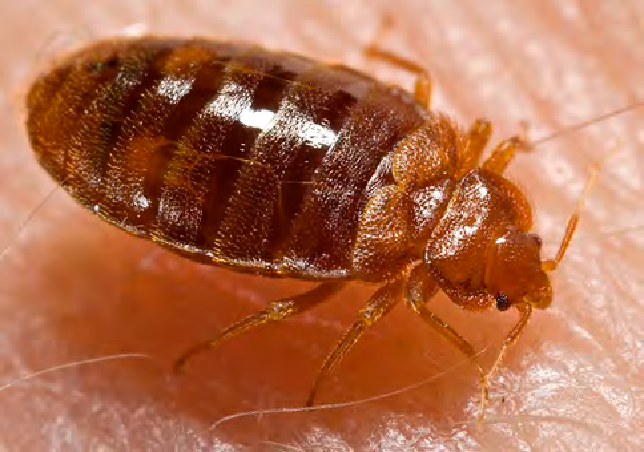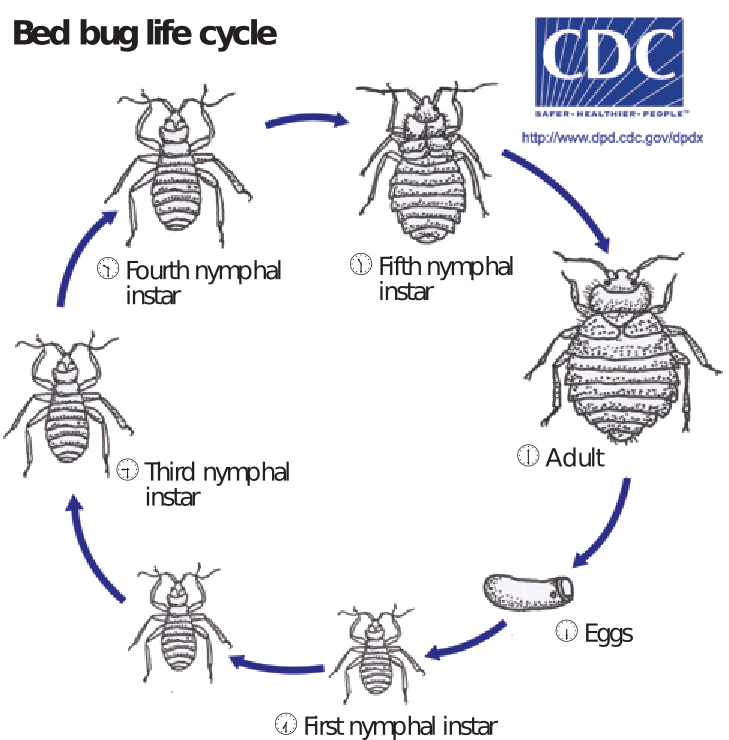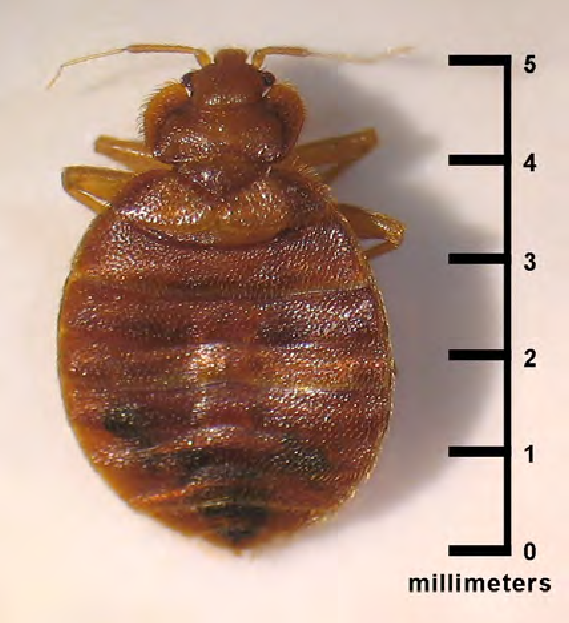Bed Bugs
PMC-00201 View this publication in PDF form to print or download.
What is a bed bug?
Bed bugs are small, wingless insects approximately ¼ inch in size. They have a reddish-brown color and are oval shaped. While the term “bed bug” can actually refer to several different related species, in this part of the world we are most concerned with Cimex lectularius. These insects commonly live in blankets, mattresses, furniture, floors and walls near sleeping areas. They survive by using specialized piercing mouthparts to bite humans and feed on their blood. While they are large enough to see, they are very good at hiding in seams and crevices. They usually leave their hiding places during the night to bite sleeping victims.
Unlike many other parasites, bed bugs can be seen with the naked eye and can, therefore, be identified by anyone with a flashlight and keen eyesight.
History
Bed bugs have been a pest to humans throughout much of recorded history. Up until the 1940s and ‘50s bed bugs were a common pest in American homes. As a result of increases in hygiene, improved living conditions and new pesticides, rates of infestation dropped dramatically during the mid-20th century (though not in all parts of the world). In recent years there has been a nationwide resurgence in bed bug infestation. Alaska has not been immune to this trend; health agencies and pest control companies across the state are receiving increasing reports of bed bug infestations.

Cimex lectularius
While no one knows for certain why bed bugs are coming back, there are a few theories. An increase in travel and tourism from all parts of the world could be introducing bed bugs into our communities. It is easy for travelers to unintentionally transport bed bugs in clothing or luggage. Another theory involves the change in pesticide management in the last few decades. A trend towards less toxic pesticides, as well as less pesticide use in general, may have contributed to the return of these insects. Additionally, bed bugs have become resistant to some modern insecticides. A third theory suggests that Americans have simply become complacent because most of the population has never had to cope with bed bugs. Americans lack the experience to identify and swiftly combat this once-common scourge.
Signs of an infestation
Some people suspect they have a bed bug infestation because they wake up with a rash or small bite marks. Others notice the bed bugs’ small, dark droppings on their bedding or small specks of blood from bites. The only way to know for certain if you have bed bugs, however, is to locate the bugs themselves. Carefully inspect mattress edges and seams and the cracks and crevices of furniture. Since bed bugs are large enough to see, a good flashlight is all you need to identify an infestation. They are most active at night, so that is the best time to look for them. Look carefully! They often hide in small, undisturbed places like mattress and furniture seams. In some parts of Alaska, private pest control companies may be able to provide specialized tools and expertise to detect bed bugs.
Prevention
Bed bugs spread from one place to another by “hitchhiking” on things like clothing, luggage and furniture. Commonly, bed bugs are spread by houseguests, secondhand clothing, used furniture and used mattresses. Wash and dry used clothing at high temperatures. Inspect mattresses and furniture for insects.
Many infestations begin when travelers stay in dwellings infested with bed bugs and unwittingly carry them back to their own homes. Because hotels host so many guests, they are particularly vulnerable to bed bugs. For this reason, hotel guests should be particularly wary. An inspection of hotel mattress edges and seams can alert you to signs of infestation. Bed bugs commonly hitchhike in luggage. Do not store clothes or suitcases on a hotel bed or floor. Use the closet or a luggage stand. If you see signs of bed bugs, alert hotel management.

 While a messy house doesn’t cause infestations, it is important to remember that cleanliness
is a critical component in any pest control and prevention strategy.
While a messy house doesn’t cause infestations, it is important to remember that cleanliness
is a critical component in any pest control and prevention strategy.
Eradication
While bed bug infestations can be challenging to deal with, cleanliness is the cornerstone of bed bug eradication. Bed bugs thrive in hidden, undisturbed places, such as piles of clothes and bedding. Eliminating clutter will reduce hiding places. Additionally, using commercial caulks and sealants to fill cracks in walls near sleeping areas can also eliminate potential hiding places for bed bugs.
Washing and drying clothing and bedding at high temperatures (greater than 120°F) and vacuuming carpets will eliminate some bed bugs. Remember to discard contents of vacuum after vacuuming. Physical cleaning of seams and crevices with a brush and soapy water will dislodge bed bugs and their eggs.
One simple way to deal with an infested mattress is to use a mattress bag. These large plastic bags (sometimes called “encasements”) are available online or at many large stores and start at less than $30. You can still sleep on the mattress, but the bag prevents any bed bugs already living in your mattress from escaping. The box spring should also be covered with an encasement.
Temperature is another important weapon we have in Alaska. Bed bugs are sensitive to cold temperatures. Exposing bed bugs to very cold temperatures (less than 0°F for at least four days) will kill them — the colder, the better. Unfortunately, large items such as mattresses take a very long time to cool down so this tool works better for small items than large ones. Worried about that teddy bear? Stick him in a plastic bag and put him in the freezer for a few days.
Thermal heat treatments are another nonchemical tactic for combating infestations. Exposing bed bugs and their eggs to a temperature of 118°F for 90 minutes will kill them. Like freezing, this approach works well for small items that can be placed in a clothes dryer. Heat treatment of homes is best left to pest control professionals with specific knowledge and equipment.
If bed bugs are not eliminated from the entire house, even a small number can recolonize all parts of a home. For this reason, it is important to eradicate bed bugs throughout the house simultaneously. While this can seem like an overwhelming project, it is the only way to ensure success. Furthermore, collaboration among tenants in multifamily housing units is necessary to successfully control bed bugs.
What about pesticides?
Pesticides can be important tools in bed bug control programs; however, there are several things to consider when determining your bed bug control strategy. Increasing pesticide resistance, as well as the general tenacity of bed bugs, makes chemical control challenging. There are human health concerns whenever chemical poisons are used within a home, especially around children. Additionally, in many parts of Alaska, pesticides can be expensive and difficult to acquire, making them an impractical option for many families.
The use of “foggers” or “bug bombs” may actually worsen an infestation by forcing bed bugs into other rooms. Fogging sprays rarely penetrate far enough into cracks and crevices to be effective, and they will not kill bed bug eggs. These products also leave behind a chemical residue on the contents of your home.
While many pest-control experts advise that pesticides have an important role in the battle against bed bugs, chemical controls can only be effective when used in conjunction with nonchemical approaches, such as fastidious cleaning, physical removal of bugs and their eggs, hot-water laundry, freezing temperatures and mattress bags. One low-toxicity product that may be useful for hard-to-reach places is diatomaceous earth. While not a stand-alone solution, diatomaceous earth that is formulated and labeled for insect control is both inexpensive and nontoxic. Regardless of the specifics of the situation, it is sensible to focus on nonchemical techniques before considering pesticides.
Over-the-counter pesticides available at home stores are generally ineffective against bed bugs and are often harmful to human health. For this reason, their use is discouraged. If you do decide to use insecticides in your home, caution should be used. Thoroughly read all labels and follow manufacturer’s instructions. They are there for your safety. Here are some other tips:
- Only use an EPA-registered product; you can find this information on the product label.
- Pesticides are most effective in the hands of certified professionals. Pest management professionals have access to a wider variety of chemicals, and they know how best to use them. They are also more likely to have up-to-date knowledge about the most effective treatment options.
- Never use a pesticide indoors that is labeled for outdoor use. It is very dangerous.
- Using the wrong pesticide or using it incorrectly to treat for bed bugs can make you sick, may not solve the problem and could even make things worse by causing the bed bugs to hide or by “pushing” them into other areas.
Bed bugs are a frustrating problem for many Alaskans, but they are can be eradicated by applying proven, evidence-based strategies. For more information, contact your local Cooperative Extension Service office.
References
Anderson, Alice, M.S., Ph.D. and Korin Leffler. 2008. “Bedbug Infestations in the News: A Picture of an Emerging Public Health Problem in the United States.” Journal of Environmental Health 70(9).
“Bed Bug Information.” U.S. Environmental Protection Agency:
“Joint Statement on Bed Bug Control in the United States.” U.S. Centers for Disease Control and Prevention (CDC) and the U.S. Environmental Protection Agency (EPA). Updated February 2011.
https://stacks.cdc.gov/view/cdc/21750
Pinto, L.J., R. Cooper and S.K. Kraft. 2007. Bed Bug Handbook: The Complete Guide to Bed Bugs and Their Control, 1st edition. Mechanicsville, Maryland: Pinto & Associates, Inc.
Romero, Alavaro, Michael F. Potter, Daniel A. Potter and Kenneth F. Haynes. 2007. “Insecticide Resistance in the Bed Bug: A Factor in the Pest’s Sudden Resurgence?” Journal of Medical Entomology 44(2): 175–178.
Olson, J., M. Eaton, S. Kells, V. Morin and C. Wang. 2013. “Cold Tolerance of Bed Bugs and Practical Recommendations for Control.” Journal of Economic Entomology 106(6): 2433-2441.
Leif Albertson, Extension Faculty, Health, Home and Family Development. Originally written by Leif Albertson and Michael Rasy, former Statewide Integrated Pest Management Technician.
Revised October 2024
